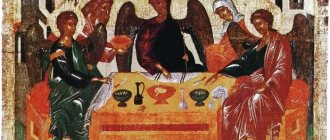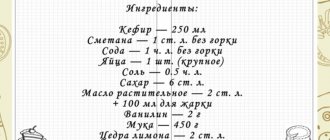An Orthodox funeral is preparation for burial, the burial itself, and commemoration of the deceased according to the canons of the Russian Orthodox Church.
Earthly life in Christianity is understood as a preparation for resurrection and eternal life, in which the soul and body will abide, which after the resurrection will rise incorruptible. Therefore, death is the sleep of the body or the dormition in Church Slavonic. A deceased person is understood as deceased, that is, asleep. The body falls asleep and rests, and the soul goes towards God. Hence the word “deceased” - a person who is at peace after the troubles of earthly life. The body and soul of a person will be resurrected, so it is necessary to provide him with a worthy burial.
How the funeral ceremony takes place: rules
During a funeral, the most important thing for true believers is prayer. But it is also worth paying attention not only to the soul of the deceased, but also to his body. The body of a Christian is sanctified by the Communion of the Divine Body and Blood of Christ the Savior. Orthodox believe that the body will come to life again during the General Resurrection of the Dead.
Therefore, there are Orthodox canons according to which it is worth burying the deceased with dignity:
- Ablution is a rite of purification.
- Dressing - the body of the deceased is dressed in clean, maybe even new, things.
- Position in the coffin - eyes should be closed, lips closed, hands placed crosswise.
- Funeral vigil - memorial services (funeral prayers) are sung for the deceased.
- The funeral service in the church is a funeral service.
- Burial - the clergyman reads the rite of interment over the coffin, after closing the lid it is poured with oil, those who say goodbye throw handfuls of earth into the grave. A cross is erected over the grave as a symbol of the faith of the deceased.
- Funeral - relatives and friends remember the deceased with kind words. Funeral services are held three times - on the day of burial on the 3rd day after death, on the 9th (nine) and on the 40th (fortie).
The actual burial begins on the third day.
During force majeure circumstances (war, epidemic, natural disaster) it is allowed to bury earlier than this line.
Preparation for burial of the body
- The first thing that is done with the body of the deceased is washing. According to Orthodox norms, you should wipe the body with cross-shaped movements, starting from the head, using a sponge soaked in water. During the process, it is customary to read the Trisagion. It is customary to burn the clothes in which a person died, as well as everything that was used during ablution.
- After the body has been washed, they begin to dress. The deceased is dressed in clean clothes, a pectoral cross is hung around his neck and placed on a special bed with his head facing east.
- Before placing the body in the coffin, the rite of placing in the coffin , or, as is customary among the clergy, in the “ark” is read. A special paper aureole is placed on the forehead, symbolizing the crown of the Apostle Paul, and the body is covered with a sacred shroud.
Orthodox traditions and customs at funerals
The consequence of this attitude towards the body of the deceased is the Orthodox Christian traditions of burial and commemoration. A brief description of how an Orthodox funeral is conducted, what day an Orthodox funeral is held, and what the Orthodox traditions of the funeral rite are are given below.
Rules for Orthodox funerals
The rules of Orthodox funerals are compliance with the canonical stages of the Orthodox rite. It is imperative to use ritual items for Orthodox funerals, prescribed by the canon.
Condolences
Send online
Send online
- ablution
- vestments
- entombment
- cross, shroud, icon
- funeral prayers for the deceased - memorial services
- funeral lithium
- funeral service
- burial
- commemoration (remembrance)
Stages of the Orthodox funeral rite
Ablution
Ablution is a rite of purification. The body of the deceased appears before the Lord pure and immaculate.
vestment
The deceased is dressed in clean clothes, a cross is put on him, covered with a white shroud, sprinkled with holy water, and placed in a coffin, which is placed with the head facing the icons.
Entombment
Close the deceased’s eyes, close his lips, and place his hands with the enclosed icon or cross in a cross shape.
Funeral vigil
Before the body is removed, funeral prayers are performed for the deceased - memorial services. You need to start after placing the clothed body on the table, then in the church. Before removing the body, a funeral litany is read.
Funeral service in the temple
The funeral service ends with a funeral litia.
Burial
When lowered into the ground, the clergyman reads the litiya, then sprinkles earth on the shroud of the deceased, after which a lid is placed on the coffin. If the clergyman is not at the funeral, the ceremony of interment is performed in the church, and the mourners are given earth, which they sprinkle on the body before closing the coffin.
After closing the coffin and lowering it into the ground, the priest pours oil on the coffin, sprinkles it with ashes and grains of wheat, then with earth. Those saying goodbye throw a handful of earth into the grave. Committing the body to the earth symbolizes the hope of resurrection - the body will sprout like a grain thrown into the ground.
Grave cross
A cross is placed at the head of the grave as a confession of faith in the Lord, who on the cross conquered death and called all living to follow his path.
Burial time
3rd day after death.
Wake
This is a ritual of remembering a person and his good deeds, as well as praying for the repose of his soul. Funeral services are held three times: on the day of burial, on the 3rd day after death, on the 9th (nine) and on the 40th (fortie).
Funeral service on the day of burial
It is held immediately after the burial in remembrance of the Resurrection of Christ on the third day after his execution. For the first two days after death, the soul of the deceased remains on earth and carries on a conversation with himself, family and friends.
Everyone who accompanied the deceased to the cemetery is invited to the memorial meal, as well as those who were unable to attend. Before the start of the funeral, a relative of the deceased stands in front of the images with a burning lamp and reads the 17th kathisma of the Psalter, after which everyone reads the prayer “Our Father”. When starting the meal, everyone makes the sign of the cross. During the remembrance they talk about the deceased.
Funeral table menu
The first dish is kutia - a mixture of whole grains of rice (or wheat), raisins and honey. Grains are a symbol of the Resurrection (the body of the deceased will sprout like a grain). Kutya is consecrated in the church at a memorial service. Each participant in the ritual eats this dish. In addition to kutya, they eat pancakes and drink jelly and sato (water with honey). In Lent the memorial meal is lenten, in the meat-eating meal it is lenten.
Devyatiny
These commemorations are sent to the glory of the angels, who ask the Lord to have mercy on the deceased. On the ninth day after repose, the soul of the deceased appears before the Lord for worship, therefore the ritual and prayers of the 9th day help the soul pass this test with dignity. On nine days a memorial service is served, and the relatives of the deceased are invited to the meal. After the second commemoration, from the 9th to the 40th day, the soul of the deceased goes to hell and realizes the sins he has committed.
Forties
Held in honor of the Ascension of the Lord on the 40th day after the Resurrection. On this day, the fate of the deceased is decided, whom the Lord judges according to earthly affairs and the achievements of the soul, after which he assigns him a place according to his deserts in anticipation of the Last Judgment. The deceased is remembered on this day so that his soul appears before the Lord and receives the promised bliss in heaven. The purpose of the fortieth day is to try to atone for the sins of the deceased.
The purpose of the fortieth day is to try to atone for the sins of the deceased.
After the forties, the deceased is commemorated on birthdays, deaths and name days.
FUNERAL ORGANIZATION
ACCORDING TO THE ORTHODOX RITE
MORE DETAILS
The attitude of the Orthodox Church towards cremation
The Orthodox Church has a negative attitude towards cremation, since after the resurrection the body must rise before the incorruptible Lord, and burying the body in the ground expresses for Christians the hope of resurrection. That is why the Christian Church has adopted and preserves the custom of not destroying the body (burning), but burying it in the ground - like a grain is sown in the ground so that it comes to life and sprouts. The church allows cremation only in cases where there is no other option. A blessing for cremation must be obtained from a priest, describing the circumstances of the case. It is not permitted to bring an urn with ashes to church after cremation for the funeral service. If a person is cremated, it is possible to order only a shortened funeral service for him - an absentee funeral service.
Due to various socio-economic circumstances in Russia, more and more believers prefer cremation to burial.
Signs, customs and traditions
There are a huge number of superstitions, customs and traditions associated with the funeral ritual. People instinctively want to protect themselves from dark thoughts about death and what awaits them after it. Whether to believe in them or not is something everyone decides for themselves. The following are the most common of them:
- It is believed that the coffin cannot be carried by the relatives of the deceased.
- It is not recommended for pregnant women and minor children to attend funerals.
- A widow or widower should not wear a wedding ring.
- After burial, you cannot take anything with you from the cemetery.
- Unmarried girls and women are buried in their wedding attire.
- After a person has died in the house, it is very important to tightly cover every mirror in the house for 40 days, and not open it, not even look at yourself. Otherwise, they will become a trap for the soul of the departed person, and he may be stuck in this world forever.
The loss of a loved one is always a great grief. But you shouldn’t give up on your own life. Remember your loved ones with kind words, light candles for their repose, but do not become despondent.
Organization of funeral rites for Orthodox Christians - Ritual.ru
The funeral service Ritual.ru will help you conduct a funeral according to the Orthodox rite and organize the funeral service in temples and churches in Moscow and the Moscow region. We have been working in the ritual sphere for 25 years and during this time we have organized more than 40,000 Orthodox funerals with funeral services.
You can consult on any questions you are interested in by calling the 24-hour city information service 8 (495) 100-3-100.
You might be interested:
- Temples in cemeteries
- Parents' Saturday - All days of remembrance in the Orthodox calendar
- Procedure after a funeral in the Orthodox tradition
About Christian burial of the dead
The document was approved by the decision of the Holy Synod of May 5, 2015 (magazine No. 30).
From the very beginning of the Church’s existence, the proper burial of the bodies of deceased Christians has been one of the important aspects of its life. In the ancient Church, the Christian community ensured that its members were not deprived of proper burial, accompanied by funeral prayers.
Funeral customs of Christians are determined by the belief in the bodily resurrection of the dead (Isa. 26:19; Rom. 8:11; 1 Cor. 15:42–44, 52–54; Phil. 3:21) and the attitude towards the body of a Christian as the temple of God ( 1 Cor. 3:16). “In the rite of Christian burial, the Church expresses the veneration due to the body of a deceased person” (Fundamentals of the Social Concept of the Russian Orthodox Church, XII, 7). Burying the body in the ground, as well as in coffins or caves carved into stone, corresponds to the Church’s belief that the day of general resurrection will come when “the earth will spew out the dead.”
(Isa. 26:19) and
“what is sown in corruption will be raised in incorruption”
(1 Cor. 15:42).
“Until then the dust will return to the earth as it was;
and the spirit will return to God, who gave it” (Eccl. 12:7), says the word of God.
The Church believes that the Lord has the power to resurrect any body and from any element (Rev. 20:13). “We are not afraid of any damage in any method of burial, but we adhere to the old and better custom of interring the body,” 1 wrote the early Christian author Marcus Minucius Felix.
Taking into account the ancient tradition of reverent attitude towards the body of a Christian as a temple of the Holy Spirit, the Holy Synod recognizes the burial of deceased Christians in the ground as the norm.
In the case where such burial is not provided for by local secular legislation or is associated with the need to transport the deceased over long distances or is impossible for other objective reasons, the Church, considering cremation an undesirable phenomenon and not approving of it, may treat the fact of cremation of the body of the deceased with leniency. After cremation, the ashes must be interred. At the same time, pastors should remind the relatives of the deceased and those responsible for organizing burials of the church’s attitude towards cremation.
The Church prays for the repose of the souls of those of its children whose bodies, due to various circumstances, were buried in the water element, abandoned on the battlefield, burned in fire, became food for animals or fish, or disappeared unknown as a result of earthquakes and various disasters2. Many holy martyrs of Christ, both in ancient and recent times, did not receive a Christian burial, including prayer instructions, which did not deprive them of eternal salvation and the glory of the Heavenly Kingdom. Bearing this in mind, the Russian Orthodox Church does not deprive Christians of prayerful remembrance who, for various reasons, were not granted burial in accordance with church tradition.
An absentee funeral service, that is, the rite of burial without bringing the body of a deceased Christian to the temple (or inviting a priest to perform it in another place) is performed when relatives have no other opportunity to participate in the burial of a Christian who fell on the battlefield, or drowned in a shipwreck, or died as a result of a plane crash, terrorist attack or other emergency circumstances, as well as in a situation of many years of unknown absence when establishing the fact of death. If it is impossible to establish the fact of death, the issue of funeral services in absentia is decided based on the duration of human life. Funeral services in absentia are also possible for persons whose relatives do not wish to have the burial ceremony performed over them.
However, even in such circumstances, pastors should encourage members of his family and people close to him to participate in prayer for the deceased, so that all who love
the deceased, his
brothers and friends, relatives and friends
responded to the last need of the deceased from temporary life and offered up a fervent prayer for him to Christ God3. In any case, those who have made a request for it should be encouraged to participate in the funeral service. The practice of “issuing land” and “issuing a prayer of permission” in isolation from the funeral service, performed in the presence of relatives or loved ones of the deceased, is unacceptable.
We should not forget that joint prayer at the burial of a loved one for many of our contemporaries who have not received a proper Christian upbringing may be the first experience of meaningful participation in church life and contact with the realities of another, eternal existence. Therefore, pastors should accompany the funeral service with an appropriate word addressed to relatives and friends.
With God everyone is alive. Orthodox burial rite. Comfort to the grieving. Prayers for the departed
Burial rite
Washing and dressing the deceased. How to pray for a person in the first days after his death. Carrying out the body. Church funeral service. Funeral service in absentia. Burial.
Washing and dressing the deceased
. Not a single nation left the bodies of their dead without care, and burial was always accompanied by appropriate rites.
The holy faith of Christ forces us to look at a Christian with respect even when he lies lifeless and dead. Now the body of this Christian is the prey of death, a victim of corruption, but still he is a member of the Church of Christ. In the ruins of this once majestic temple, the life-giving Spirit of God moved, lived and acted (see: 1 Cor. 6: 15-19). The body of a Christian is sanctified by the communion of the Divine Body and Blood of Christ the Savior. Is it possible to despise the Holy Spirit, whose temple was the deceased? Subsequently, this dead and corruptible body of a Christian will come to life again and will be clothed with incorruption and immortality (see: 1 Cor. 15: 53). Therefore, our Orthodox Church does not leave her child without maternal care even when she has passed from this world to the distant and unknown land of eternity.
The touching rituals performed by the Church over the tomb of a Christian have a deep meaning. They are based on the inspirations of the holy faith, originating from the divinely enlightened Apostles and the first Christians.
The body of the deceased is washed immediately after death. Ablution should extend to all parts of the body. Washing is performed as a sign of the spiritual purity and integrity of the life of the deceased, as well as so that he appears in purity before the face of God after the general resurrection.
You need to wash your body with warm water, but not hot, so as not to steam it. When they wash the body, they read the Trisagion (“Holy God, Holy Mighty, Holy Immortal, have mercy on us”) or “Lord, have mercy.” A lamp or candle is lit in the house and burns as long as the deceased is there.
When washing, you need to use soap, a soft cloth or sponge.
After washing, the Christian’s body is dressed in new light clothes. New clothes seem to indicate a new garment of our incorruptibility and immortality (see: 1 Cor. 15: 53). Clothes are worn according to the person's rank or service. They depict that after the resurrection a person must give an account to God of how he fulfilled his duty in what he was called to do.
If suddenly a person was not wearing a cross at the time of his death, then after washing he must put it on.
The hands and feet of the deceased are tied (they are untied before leaving the house). Hands are folded so that the right one is on top. An icon (or cross) is placed in the left hand of the deceased: for men - the image of the Savior, for women - the image of the Mother of God. You can do this: in your left hand - a cross, and on your chest - a holy image. This is done as a sign that the deceased believed in Christ and surrendered his soul to Him, that in life he foresaw (always had) the Lord before him, and now moves on to the blissful contemplation of Him with the saints.
When the time comes to place the deceased in a coffin, then holy water is sprinkled on the body of the deceased and the coffin inside and out. You can also cover it with incense. The body is then transferred to the coffin.
A whisk is placed on the forehead of the deceased. It is given in the church when the deceased is brought there for the funeral service. Some people buy it for themselves in advance. A deceased Christian is decorated with a crown like a fighter who has left the field of achievement with honor, like a warrior who has won a victory. On the corolla there is an image of the Lord Jesus Christ, the Most Pure Mother of God and John the Baptist with the inscription: “Holy God, Holy Mighty, Holy Immortal, have mercy on us.” This shows that he who has completed his earthly life hopes to receive a crown for his exploits (see: 2 Tim. 4:7 - only through the mercy of the Triune God and the intercession of the Mother of God and the Forerunner of the Lord John.
It is given in the church when the deceased is brought there for the funeral service. Some people buy it for themselves in advance. A deceased Christian is decorated with a crown like a fighter who has left the field of achievement with honor, like a warrior who has won a victory. On the corolla there is an image of the Lord Jesus Christ, the Most Pure Mother of God and John the Baptist with the inscription: “Holy God, Holy Mighty, Holy Immortal, have mercy on us.” This shows that he who has completed his earthly life hopes to receive a crown for his exploits (see: 2 Tim. 4:7 - only through the mercy of the Triune God and the intercession of the Mother of God and the Forerunner of the Lord John.
A pillow, usually made of cotton wool, is placed under the shoulders and head of the deceased. The body is covered with a sheet. The coffin, as a rule, is placed in the middle of the room in front of household icons, turning the face of the deceased towards the exit.
Candles (or at least one candle) are lit around the coffin as a sign that the deceased has moved to the realm of Light - to a better, afterlife.
How to pray for a person in the first days after his death.
When the body of the deceased is washed and dressed, they immediately begin to read the canon called “The Sequence of the Exodus of the Soul from the Body”[1]. If a person died not at home and there is no body at home, then on the day of his death this canon is still read.
The canon should be read from the initial prayers, then Psalm 90, then in the order indicated in the prayer book.
Like the previous canon, the “Succession” is divided into nine cantos. Before the troparia (songs starting with a red line) the verse (chorus) is read: “Rest, O Lord, to the soul of Thy departed servant (Thy departed servant)” with the addition of the full
name of the deceased.
The canon is read “for the one who died,” that is, for a person who has just died; therefore, when reading the refrain “Rest, O Lord, the soul of your departed servant,” you should not pronounce the names of recently deceased acquaintances, parents, relatives, etc. The canon is read only for one
.
At the end of the “Followment” there is a special prayer appeal to God with the pronunciation of the name of the deceased: “Remember, O Lord our God, in the faith and hope of the eternal life of the departed Thy servant (Thy servant), our brother (our sister) (name
[2]
)...".
After this prayer they read: “Eternal memory to Thy servant (Thy servant)
(name),
Lord.”
“Following” is read with the purpose that God’s mercy, through our prayer for the deceased, will ease the soul’s bitterness at parting with the body and the first moment of the soul’s stay outside the body.
Here are the prayer requests from this canon: “The deceased departed from us, placing his hope in You, Savior. But You, Lord, the Most Merciful God, grant him generous forgiveness” (5th canto); “Hear, O Holy Trinity, the words of prayer offered to You in the church for the deceased, and illuminate with Your Divine light the soul darkened by vain attachments to earthly life” (4th canto); “One Pure and Immaculate Virgin, who gave birth to God without a seed, pray to his (the deceased) soul to be saved” (from the initial troparion).
Then, for three days, the Psalter is read over the deceased. They begin to read it with the petition: “Through the prayers of our saints, our fathers, Lord Jesus Christ our God, have mercy on us. Amen". Next, the opening prayers and those that precede the psalms are read.
The Psalter is divided into twenty large parts - into kathismas. Before each kathisma, the call to worship God is repeated three times:
“Come, let us worship our God the King.
Come, let us worship and fall down before Christ, our King God.
Come, let us bow down and bow down to Christ the King Himself and our God.”
After this, the kathisma is read. At the end of several psalms, separated by the word “Glory,” it is said three times: “Alleluia! (three times).
Glory to You, God!” and the prayer request for the deceased from the “Succession” is repeated: “Remember, O Lord our God, in faith and hope...”. After this prayer, the reading of the psalms of the 1st kathisma continues (then the 2nd and so on).
In each kathisma, “Glory” is read three times; therefore, three times during the reading of the kathisma, an appeal to God should be made with a special request (prayer) for mercy on the deceased.
The Psalter is read continuously
(day and night) over the tomb of a Christian all the time while the deceased remains unburied.
Since the closest relatives of the deceased in the first three days have a lot of household worries about organizing the funeral, one of their friends or acquaintances is invited to read the Psalter. Any pious layman can read the Psalter for the deceased.
Not without reason and not without purpose, the Church from ancient times ordered the book of psalms to be read over the tomb of the deceased, and not another book of Holy Scripture. The Psalter reproduces all the diverse movements of our soul, vividly sympathizes with both our joy and our sorrow, and sheds a lot of consolation and encouragement into our grieving heart. The death of our neighbors awakens in us so many different feelings and thoughts! Reading the Psalter serves as a prayer to the Lord for the deceased and quenches the grief of loved ones for the deceased...
This book is such that anyone who prays and reads it can pronounce its words as if they were their own, which cannot be said about any other book. Therefore, when you hear the monotonous voice of a reader over the grave of a Christian, you imagine that the prayer of the inspired King-Prophet David is, as it were, pronounced through the lips of the deceased himself. It is as if he himself from the grave begs the merciful God for his mercy.
Carrying out the body.
An hour or an hour and a half before the coffin is taken out of the house, the “Sequence on the departure of the soul from the body” is read once again over the body of the deceased.
The coffin is taken out of the house, turning the face of the deceased towards the exit. When carrying out the body, the mourners sing a song in honor of the Holy Trinity: “Holy God, Holy Mighty, Holy Immortal, have mercy on us” - to commemorate the fact that the deceased confessed the Life-Giving Trinity during his lifetime and now passes into the Kingdom of disembodied spirits surrounding the Throne of the Almighty and silently chanting The Trisagion hymn to him.
Church funeral service.
In the church, the coffin with the body of the deceased is placed in the middle of the church facing the altar and lamps are lit on four sides of the coffin.
According to the teachings of the Church, the human soul goes through terrible ordeals on the third day after death. At this time, the soul of the deceased has a great need for the help of the Church. To facilitate the transition of the soul to another life, the canon and Psalter are read over the coffin of an Orthodox Christian, and the funeral service is performed in the church.
The funeral service consists of chants in which the whole fate of man is briefly depicted - for breaking the commandment, he again turns to the ground from which he was taken: “You yourself, the Creator and Maker of man, alone are immortal; and we are all earthly, created from the earth and will return to the same earth, as You, the Creator, commanded: you are the earth and you will return to the earth.
That’s where all of us earthlings will go, with funeral sobs, shouting the song: Alleluia, Alleluia, Alleluia.”
But, despite the multitude of sins, man does not cease to be “the image of the glory of God,” and therefore the Holy Church prays to the Master and Lord, by His ineffable mercy, to forgive the deceased’s sins and to honor him with the Kingdom of Heaven; “With the saints, O Christ, rest the soul of Your servant, where there is no illness, sorrow and suffering, but life is eternally blessed.”
In order not to leave room for sadness in the suffering heart and not a single cloud of doubt that can be born in the soul at the sight of the destruction of the most beautiful of God’s creations (man), the Apostle Paul raises his consoling voice, transfers our thoughts beyond the tomb and reveals wondrous secrets to us future glorious transfiguration of the human body (see: 1 Thess. 4: 13-17). Finally, Jesus Christ Himself, through the lips of the priest, consoles and encourages us, sheds consolation and joy in a heart torn by grief and sadness: the funeral Gospel of John is read (see: John 5: 25-30).
After reading the Apostle and the Gospel, the priest reads a prayer of permission.
This prayer resolves the deceased’s sins, which he repented of (or which he could not remember during repentance), and the deceased is released in peace to the afterlife. The text of this prayer is immediately placed in the right hand of the deceased by his loved ones.
The last kiss, or farewell to the deceased, is performed while singing touching stichera (prayers): “Come, brothers, let us give our last kiss to the deceased, thanking God...”. Translated from the Slavic language, this prayer sounds like this: “Come, brothers! Let us give our last kiss to the deceased, giving thanks to God. So he left his relatives and hurries to the grave, no longer caring about the vanity of earthly things and the long-suffering flesh. Where are your family and friends now? Now we are separated from him... Let us pray to the Lord to give him peace.”
DESCRIBLY FUTURE SEQUENCES
Regarding funeral prayers for the dead by Orthodox priests about non-Orthodox Christians, different opinions are expressed. According to some, such prayers are possible, but according to others, they are completely unacceptable in any form. Church canons – 10 St. Ave. Apostle, 2 Antiochus. With. 6 and 33 Laodicea. – they resolutely prohibit all prayerful communication with non-Orthodox people. With this prohibition, the Holy Church aims, on the one hand, to protect the Orthodox from seduction, and on the other hand, to keep them from religious indifference. In this regard, the Church follows only the instructions of the holy apostles, who commanded not to communicate with all kinds of idolaters (1 Cor. 5:9-10), with people preaching non-Orthodox teachings (2 John 1:10). But this does not mean at all that all prayer for non-Orthodox people is prohibited. The apostles themselves made it a duty for all Christians to pray in general “for all men” and in particular for unfaithful rulers (1 Tim. 2:1-2). The same holy Apostle Paul, who, in order to protect the Orthodox from temptation, in one place commands to “beware of circumcision” (Phil. 3:2), in another says: “the desire of my heart” and “prayer to God” about the same infidel “ for Israel's salvation" (Rom. 10:1). Following the instructions of the apostles, the Holy Church has always prayed for the whole world, for all people. Even in the rite of the liturgy, prayers were offered not only for the lost - heretics, but also for outsiders - pagans. For example, in the liturgy of the Apostolic Constitutions, not only the deacon proclaims: For those outside and those who are lost,
but the Bishop, at the most important moment of the liturgy, asks:
We also pray to You... for those who are external and erring, that You may turn them to good and tame their rage
653. It is known about Saint Basil the Great that he did not reject the offerings of the Arian (Emperor Valens) and allowed him to be present during the celebration of the liturgy.
True, this is all evidence of prayer for the living faithful and non-faithful, but the Lord has no dead, “for with Him all are alive” (Luke 20:38) and therefore the prayer of a Christian, as one of the types of manifestation of living Christian love for one’s neighbor, - can (and should) extend to both the living and the dead. It is known that the Monk Macarius of Egypt prayed for the pagans, and St. Gregory the Dvoeslov prayed for Trajan. It is also known that the evil persecutor of holy icons , the godless Theophilus, Queen Theodora with the holy men and confessors was snatched away from torment and saved,
as it is narrated (Synaxarion of the Meatless Saturday).
At the same time, conciliar public prayers were offered up for Theophilus in the temple. Saint Methodius the Patriarch, having gathered all the people and the entire congregation and the bishops, come to the Great Church of God... they offer an all-night prayer to God for Theophilus, all who pray with tears and prolonged prayer: and this is done throughout the first week of fasting.
The prayers of the Church did not go unheard.
The Lord Himself, appearing to Theodora in a dream vision in the form of a Certain Wonderful Man, announced: Woman, great is your faith.
Understand, therefore, that for the sake of your tears and faith, and also for the sake of the petition and prayer of My servants and My priests, I give forgiveness to your husband Theophilus (Synaxarium of the Week of Orthodoxy).
Saint Isaac the Syrian says that a person’s merciful heart kindles for all creation: “about people, about birds, about animals, about demons and about every creature. When remembering them and looking at them, a person’s eyes shed tears from the great strong pity that envelops the heart. And from great patience his heart is touched, and it cannot bear, or hear, or see any harm or small sorrow endured by the creature. And therefore, for the dumb and for the enemies of the truth and for those who harm him, he offers prayer hourly and with tears to be preserved and purified: and also for the nature of the reptiles to pray with great pity, which is immeasurably aroused in his heart due to the likeness in this to God "654. And Rev. Macarius of Egypt writes “that those who have been honored to become children of God and have within themselves Christ who enlightens them,” who are “controlled by the Spirit in various and varied ways and in the hiddenness of their hearts are warmed by grace,” are such... “sometimes in weeping and lamentation they tearfully pray for salvation of all people, because burning with Divine spiritual love for all people, they will take upon themselves the cry of the whole Adam"
655.
Metropolitan Philaret of Moscow writes about the commemoration of the departed, among other things:
“There is no doubt that it is inconvenient to turn the boldness of miracle workers into a rule, and the examples of people who have reached the highest degrees of perfection, about whom one can say according to the Apostle that for them “the law does not lie” (1 Tim. 1:9), cannot be guided by everyone. But there are often cases when Orthodox Christians would like to pray for their deceased relatives or loved ones of deceased non-Orthodox people. They will say: they can pray for them in their home prayer. But first of all, we must sadly admit that very often among us, especially the laity, they do not know and do not know how to pray for one reason or another. Alone, each person, secretly to himself, may be able to simply express his request to the Lord in his own words. But how can one pray without a priest, when several lay people would like to pray together? For an Orthodox person, it is always desirable to pray with the ministers of the Church. Yes, finally, isn’t home prayer different from church prayer mainly only in terms of setting? As has already been noted, every prayer of the Orthodox, who Orthodoxy profess the dogma of atonement, no matter where and under what circumstances it is offered, in essence is certainly a church, Eucharistic prayer. Therefore, whoever can be commemorated in home prayer can also be commemorated in church, with only a few restrictions relating mainly to the external aspect, the very order of commemoration.”
Performing a commemoration according to the Orthodox rite (especially performing a funeral service) is an open recognition and testimony by the Church of its unity in faith by its deceased member and the right to this attention of the Church and its especially strengthened intercession before God for the deceased belongs only to persons who died in unity with the Church by faith and life. This right cannot and should not be used by people who violated this unity of faith and died outside of communion with the Church, outside of her prayers and grace-filled Sacraments656.
The Orthodox funeral service, as noted earlier, is not only a prayer for the deceased, but also a celebration of them on behalf of the Church and those praying. The Church, without denying the possibility of prayers for the non-Orthodox, cannot allow their solemn celebration. That's why Rev. Theodore the Studite, not allowing open prayer for heretics, allows their Orthodox relatives to pray for such “in their souls.” Doesn’t this formula also remind one of the ancient liturgical formula restored by the Council of 1918: “of whom every one makes remembrance in his mind” (see below).
Metropolitan Philaret of Moscow, a strict zealot of the Church Rules, who was especially afraid that by making concessions to console some he would not tempt many, who believed that “the duty not to embarrass or tempt one’s own is undoubtedly higher than the duty to please others,” still found it possible in some cases make a concession. When asked about the possibility of church prayer for dead Lutherans, he answered: “This question is not very convenient to resolve. You want to have a basis for permission in the fact that Macarius the Great even prayed for a pagan who died. It is difficult to turn the wonderworker’s boldness into a general rule. Gregory the Dvoeslov also prayed for Trajan and received news that his prayer was not fruitless, but so that he would not bring such bold prayers in the future... To do the matter outside the rule for the consolation of one, but not without temptation for many, I think, would not be plausible. You can sing a prayer service for a living Lutheran and ask him for the grace of God, drawing him into the unity of the true Church, but with a deceased person it is a different matter. We do not condemn him: but it was his will to remain until the end outside the Orthodox Church. Knowing some Lutherans who had respect and faith in the Orthodox Church, but died outside union with it, for the consolation of the faithful, I allowed prayer for them, NOT OPEN IN THE CHURCH
, with which they did not openly unite in life,
but commemoration at proskomedia and memorial services in the house”
657.
On the issue of commemorating the deceased non-Orthodox, such a church person as K. P. Pobedonostsev also spoke out in a spirit of condescension: “It is obvious that, being posed in the abstract, it (this question) raises doubts that are difficult to resolve, but the internal economy of church administration resolves it in practice as needed. Indeed, both in the service and in the families of the Orthodox, we have so many Lutherans and Catholics, who often unite with the Orthodox in common home and even church prayer, that it is difficult to maintain a strictly undeviating formal point of view when Orthodox relatives, friends, and subordinates ask for church funeral prayer at the coffin at home or at the grave of the deceased. It was another thing to bring him into a church to which he did not belong. It is difficult to resist, especially since Christian love lives forever, descends deeply and floats high above all obstacles and passages of institutions658.
What and how can an Orthodox priest do at the tomb of a non-Orthodox Christian or when commemorating him?
Orthodox funeral services refer to those who died in the true Orthodox faith. It is certainly impossible to use church prayers when commemorating non-Orthodox people. How, for example, can one read a prayer about a Catholic or a Lutheran from following the exodus of the soul... even though they have sinned, but do not depart from Thee... and the Trinity... Orthodox even until their last breath of confession?
How can we sing over the deceased non-Orthodox people, who by their very unorthodoxy have deprived themselves of the right to be called “faithful” by the Church, sing the usual general canon for the departed at a funeral service, which has a characteristic edge:
“to the dying faithful I sing a hymn of praise”?
How to pronounce litanies about a non-Orthodox person without sacrificing your zeal for Orthodoxy? Saint Theophan the Recluse to the question: “Will Catholics be saved?” answered: “I don’t know whether Catholics will be saved, but I know that I will not be saved outside the Orthodox Church.”
Thus, the Orthodox should value their belonging to the Orthodox Church. If the same prayers that the Orthodox Church offers only for its departed Orthodox children are used in application to the non-Orthodox, this will be disrespect for the Orthodox Church, a manifestation of an indifferent attitude towards the Orthodox faith, an indicator of religious indifference, which if at all should not be among believers , then it is all the more unacceptable in actions carried out on behalf of the Orthodox Church and its official, deliberately elected and authorized representatives.
Back in 1797, the Holy Synod allowed Orthodox priests, when accompanying the body of a deceased non-Orthodox person in certain cases, to limit themselves only to the singing of the Trisagion. But just singing this short verse will not satisfy the desire of the Orthodox relatives of the deceased to pray for him, for which reason the participation of an Orthodox priest is allowed.
Orthodox Greeks, who treat living non-Orthodox people with great severity, and who accept even Catholics in case of conversion to Orthodoxy only through rebaptism, practically resolve the issue of prayer for deceased non-Orthodox people with great condescension. In 1869, Patriarch Gregory VI of Constantinople established a special rite of burial for the deceased non-Orthodox, which was also adopted by the 6th Hellenic Synod. This rite consists of the Trisagion, the 17th kathisma with the usual refrains following burial, the apostle, the gospel and the small dismissal.
In the last years of his stay in Tver, His Grace Archbishop Dimitri (Sambikan) sent out a confidential circular throughout the diocese, by which he allowed the clergy, in necessary cases, to pray for the deceased non-Orthodox according to the rite of requiem he composed, which consisted mainly of singing irmos.
Just before the revolution, the Petrograd Synodal Printing House published a special brochure in Slavic script, the Order of the Order of the Deceased Non-Orthodox.
In it, after the usual beginning and Psalm 27, the immaculates follow in three sections with the chorus of alleluia, but without litanies.
After the immaculate troparions for the immaculate ones - the first two (Holy Faces,
and
the Lamb of God
), Glory, Trinity, And Now, Theotokos.
Then Psalm 38. After it ikos: Himself is one ecu.
Prokeimenon. Apostle to the Romans, conception 43 (v. 14, v. 6–9), Gospel of John, conception 15 (John 5:17–24). After the Gospel from stichera for kissing 1, 4, 5, 8, 9 and 11 and the usual (not funeral) small dispensation: Risen from the dead. This rite is indicated to be performed instead of a requiem, with the omission of the Apostle, Gospel and stichera.
But even this rite of church prayer may not be performed for all unconditionally deceased heterodox Christians. The Church cannot pray for those who rejected the existence of God, openly blasphemed the Church and its faith, denied the Divinity of the Lord Jesus Christ and the dogma of atonement, blasphemed the Holy Spirit and the Holy Sacrament, and remain unrepentant of these sins. There can also be no open church prayer for suicides according to the rule of Timothy of Alexandria, as those who have encroached on the most precious gift of God - life.
The most important thing in the practical resolution of the issue of prayer for the non-Orthodox is that the Orthodox, who for one reason or another want to pray for their loved ones, although not of the same faith, do this good deed with a sense of humility, devotion to the will of God, and obedience to the Holy Church. It is unnatural for Orthodox Christians to turn prayer into a demonstration of indifference to matters of faith. And Christian love, which prompts prayer for erring brethren, will find ways to satisfy its need without violating the rules of the church: both in prayer at home, in private, and even during public worship in church - only without public worship - by commemorating them, when at all The commemoration of the deceased is carried out secretly, but silently, “in one’s soul,” according to the instructions of St. Theodore the Studite, remembering them at the proskomedia, guided by the authoritative permission of Metropolitan Philaret. If the names of deceased non-Orthodox people can be pronounced at one of the most important commemorations - at the proskomedia, then they can be included in memorials and proclaimed along with other names, but on the condition that they are not singled out from others, and that pilgrims do not pay special attention to them , do not perform Orthodox rites only for their sake. Therefore, if, for example, these names are unusual for Orthodox Christians, then they should not be included in memorials intended for public reading, but such deceased ones should be remembered when their relatives are proclaimed,
as some elders did (for example, the hieromonk of the Gethsemane monastery Porfiry, who died on April 4, 1934, a student of the hieromonk Father Barnabas). If the names of the non-Orthodox deceased do not differ from the names of the Orthodox, it is best to remember him not separately, but together with other names, certainly adding a general formula about all those who have previously died, asking for the prayerful help of those of them who have already received grace pray for others.
On May 5, 2015, a meeting of the Holy Synod of the Russian Orthodox Church was held at the Patriarchal residence in the Danilov Monastery in Moscow. At the meeting, the document “On the Christian Burial of the Dead” (journal No. 30) was adopted, expressing the Church’s attitude to the cremation and burial of the dead. The document was approved by the Synod to guide the archpastors, pastors and laity of the Russian Orthodox Church in their activities. Below is the text of the document.
From the very beginning of the Church’s existence, the proper burial of the bodies of deceased Christians has been one of the important aspects of its life. In the ancient Church, the Christian community ensured that its members were not deprived of proper burial, accompanied by funeral prayers.
Funeral customs of Christians are determined by the belief in the bodily resurrection of the dead (Isa. 26:19; Rom. 8:11; 1 Cor. 15:42-44, 52-54; Phil. 3:21) and the attitude towards the body of a Christian as the temple of God (1 Cor. 3:16). “In the rite of Christian burial, the Church expresses the veneration due to the body of a deceased person” (Fundamentals of the Social Concept of the Russian Orthodox Church, XII, 7). Burying the body in the ground, as well as in coffins or caves carved into stone, corresponds to the Church’s belief that the day of general resurrection will come, when “the earth will cast out the dead” (Isa. 26:19) and “what is sown in corruption will be raised in incorruption” (1 Cor. 15:42). “Until then the dust will return to the earth as it was; and the spirit will return to God, who gave it” (Eccl. 12:7), says the word of God.
The Church believes that the Lord has the power to resurrect any body and from any element (Rev. 20:13). “We fear no harm in any method of burial, but adhere to the old and better custom of interring the body,”[1] wrote the early Christian author Marcus Minucius Felix.
Taking into account the ancient tradition of reverent attitude towards the body of a Christian as a temple of the Holy Spirit, the Holy Synod recognizes the burial of deceased Christians in the ground as the norm.
In the case where such burial is not provided for by local secular legislation or is associated with the need to transport the deceased over long distances or is impossible for other objective reasons, the Church, considering cremation an undesirable phenomenon and not approving of it, may treat the fact of cremation of the body of the deceased with leniency. After cremation, the ashes must be interred. At the same time, pastors should remind the relatives of the deceased and those responsible for organizing burials of the church’s attitude towards cremation.
The Church prays for the repose of the souls of those of its children whose bodies, due to various circumstances, were buried in the water element, abandoned on the battlefield, burned in fire, became food for animals or fish, or disappeared unknown as a result of earthquakes and various disasters[2]. Many holy martyrs of Christ, both in ancient and recent times, did not receive a Christian burial, including prayer instructions, which did not deprive them of eternal salvation and the glory of the Heavenly Kingdom. Bearing this in mind, the Russian Orthodox Church does not deprive Christians of prayerful remembrance who, for various reasons, were not granted burial in accordance with church tradition.
An absentee funeral service, that is, the rite of burial without bringing the body of a deceased Christian to the temple (or inviting a priest to perform it in another place) is performed when relatives have no other opportunity to participate in the burial of a Christian who fell on the battlefield, or drowned in a shipwreck, or died as a result of a plane crash, terrorist attack or other emergency circumstances, as well as in a situation of many years of unknown absence when establishing the fact of death. If it is impossible to establish the fact of death, the issue of funeral services in absentia is decided based on the duration of human life. Funeral services in absentia are also possible for persons whose relatives do not wish to have the burial ceremony performed over them.
However, even in such circumstances, pastors should encourage members of his family and people close to him to participate in prayer for the deceased, so that all those who love the deceased, his brothers and friends, relatives and friends, respond to the last need of the deceased from temporary life and offer a fervent prayer to Christ for him God[3]. In any case, those who have made a request for it should be encouraged to participate in the funeral service. The practice of “issuing land” and “issuing a prayer of permission” in isolation from the funeral service, performed in the presence of relatives or loved ones of the deceased, is unacceptable.
We should not forget that joint prayer at the burial of a loved one for many of our contemporaries who have not received a proper Christian upbringing may be the first experience of meaningful participation in church life and contact with the realities of another, eternal existence. Therefore, pastors should accompany the funeral service with an appropriate word addressed to relatives and friends.
[1] Marcus Minucius Felix. Octavius // Theological works. Sat. 22. - M., 1981. P. 161.
[2] See: Canon of Matins on Saturday of the Meat and on Saturday of the 7th week of Easter, by St. Theodore the Studite.
[3] See: Stichera for kissing the deceased.










